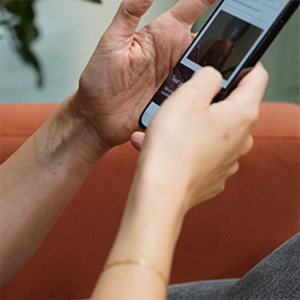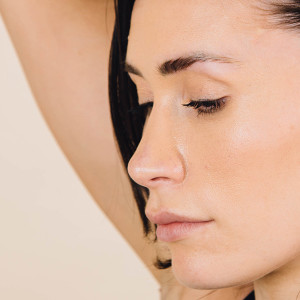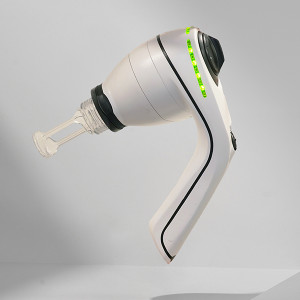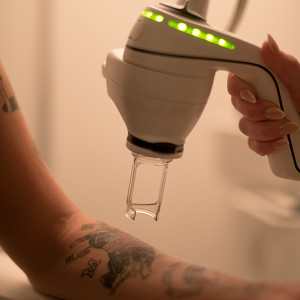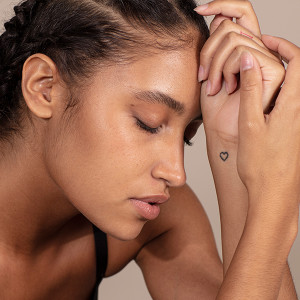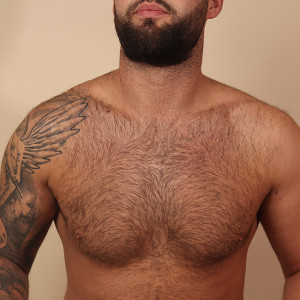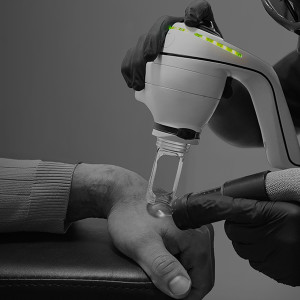
NAAMA's clients say their laser tattoo removal treatments feel virtually "pain-free."
Historically, laser tattoo removal is often seen as a painful way to get rid of unwanted ink; one that requires staying out of the sun, avoiding showers and potentially taking a sick day to recover. That's because older lasers used to break up the tattoo ink often apply a high energy dosage to a concentrated area that feels uncomfortable or painful and can cause scars, blisters and irritation that lasts for weeks at a time.
We'll dive into why choosing a cutting-edge laser designed to be gentler on the skin is a much better option to greatly reduce pain and permanent skin damage without compromising on high-quality removal results. Chances are, it won't hurt any more than getting the tattoo in the first place.
Publish Date in article


What hurts more getting a tattoo or tattoo removal?
In general, tattoo removal is typically thought of as a more painful experience than getting a tattoo. That’s because the process involves a high-intensity laser beam penetrating deep into the skin to target the ink particles, break them apart and let your body clear them out through the immune system. The pain of tattoo removal is typically described as a feeling of heat or burning on the skin, and it can last for a few minutes to several hours after the treatment. In contrast, getting a tattoo typically involves some discomfort, but it is generally not as painful as tattoo removal.
Getting a tattoo typically doesn't hurt as much as tattoo removal. The tattoo artist uses a tattoo machine to puncture the skin and inject the ink into the skin, which can cause some discomfort but is generally not as painful as the feeling of a laser beam used in tattoo removal.
Another thing to consider is tattoos are typically done in one or two sessions, whereas laser tattoo removal will take several sessions to complete.
What makes laser tattoo removal painful?
The amount of pain that a person experiences during laser tattoo removal can vary depending on a number of factors, including the size and location of the tattoo, the type of laser that is used, and the individual's pain tolerance. Some people may experience only mild discomfort during the treatment, while others may find it more painful.
Here are the main things that will factor into how painful a tattoo removal treatment might be:

Jack says tattoo removal at NAAMA "doesn’t hurt at all." He recently finished removing a star tattoo on his hip.

1. Older laser technology
Older tattoo removal laser technology may be more painful than newer technology because the older lasers were not as precise and often delivered higher volumes of energy to the skin to try and break down the ink pigment. This is often what causes discomfort and pain upon application. For example, Q-switched and carbon (CO2) lasers use high-energy beams of light that are absorbed by the tattoo ink, causing it to shatter into smaller particles. The risk with high-energy lasers is that they target the tattoo, but also the skin outside it, delivering a powerful energy dosage to break down the pigment that inadvertently can cause a great deal of harm to the tissue.
Today with modern laser removal technology, the same–if not more effective—removal results can be achieved with a more precise, accurate and lower energy laser like LightSense™. NAAMA, the only tattoo removal studio in the world using LightSense™, sees many clients that started treatment using older lasers and couldn’t continue based on how unbearable the pain was and for little to no results. They come to NAAMA looking for faster, more effective treatments that are significantly less painful—if painful at all.
“I had one session of traditional tattoo removal and it was so painful that I never went back,” says Jack after he tried an older laser technology to remove a tattoo on his hip and failing to see results. “Traditional laser tattoo removal is like someone taking a hot poker and stabbing you multiple times around the area until you can’t take it anymore; leaving you blistered and sore for weeks. I don’t even know how the skin repairs from it, it’s so bad.”
“I looked NAAMA up and was a bit apprehensive how you could remove a tattoo without it hurting. But I realised after one or two sessions that it doesn’t hurt at all and I can come back more often.” Like many NAAMA clients, Jack’s skin was healthy and maintained after treatment, allowing him to come back in less than 2-3 weeks for follow-up appointments. That’s far quicker than many other tattoo removal studios that average 4-6 weeks between tattoo removal appointments to allow the treated area to heal properly and to allow the body to break down and remove the ink particles.
2. Tattoo location
Different parts of the body are more sensitive to pain than others. These often are the extremities of the body that have higher nerve endings. In other words, they have more sensory neurons that immediately send a signal to your brain when they feel any sort of pain—faster than other parts of the body. These include: - Fingers
- Ribcage
- Wrists
- Ankles
- Armpits
- Forehead
- Elbows
3. Tattoo size
Tattoo size can impact tattoo removal pain because larger tattoos generally require more laser treatments to fully remove the ink, which can result in more discomfort or pain.
Also, a bigger tattoo will naturally have a higher chance of feeling sensitive. The surface area of skin is larger so you’ll have more sensory receptors in the area, meaning you might “feel” the treatment more than a smaller, more condensed location. A larger sized tattoo on a sensitive area of the body can also be more receptive to pain.
4. Pain tolerance
No two people experience pain the same. For many of us, we have a varying threshold that can change and impact our pain tolerance. Things like stress, negative headspace and hormonal fluctuations all might make someone feel more susceptible to pain, whereas feeling more positive or having a higher dose of estrogen coursing through the body can act as natural pain relievers.
If you find you’re more sensitive at different times of the month, for example around your menstrual cycle or during a big project at work, you can work with your tattoo removal consultant to schedule your appointments around these moments.
Together, all these elements can greatly impact whether you might find treatment to be painful. Any combination of them might increase the chances too, but there are several things that can be bypassed if you pick a studio with a top-of-the-line laser like NAAMA. We’ll get into why that is next.
Publish Date in article


Are there less painful tattoo removal lasers to choose?
Yes, indeed. NAAMA’s tattoo removal is often described by clients as pain-free. That’s because the LightSense™ laser’s lower energy is controlled, precise and effective at breaking down tattoos without causing unnecessary damage to the skin. “It was almost pain-free,” said Jane of her treatments at NAAMA. Now that kind of review is hard to pass up.
With LightSense™, you can expect:
Less energy, more efficacy
LightSense™ achieves effective results using 34x less energy than the average Pico laser. And you’ll experience healthy, smooth skin after every treatment. Does laser tattoo removal leave scars? Not with the LightSense™ laser system; NAAMA has seen less than 1% chance of scarring in its clients.
Removals in months, not years
Treat as often as every 2-3 weeks and experience faster results in less time.
Bespoke treatments
The team's expertly trained consultants are the only people in the world certified to use the LightSense™ laser. They’ll create a personalised plan to suit your skin, tattoo and removal goals.
Superior colour removals
It’s safest laser to use on all skin types, tones and all tattoo colours. In fact, LightSense™ is the leading laser to treat both black and coloured inks effectively with rapid results.
Numbing creams
While numbing can help temporarily “freeze” the area, they might interfere with the effectiveness of treatment. Melina, head studio manager at NAAMA, recommends speaking to the team to advise the best types to use if you’re keen.
Painkillers
While many clients at NAAMA find they don’t need any painkillers ahead of treatment, if you choose to take any, take paracetamol 30 minutes before your session. Do not take ibuprofen as it can thin the blood which can sometimes increase the risk of bleeding during treatment
To keep pain at bay after treatment, it’s important to follow your aftercare protocol from your consultant that will outline these steps:
1. Keep the medical dressing on so that the treated area stays clean and protected.
2. Stay out of direct sunlight on the treated area for at least 6 weeks.
3. Apply a thin layer of aftercare cream designed with nourishing ingredients to boost cell regeneration, soothe irritation and provide long-lasting hydration until the area is healed. We recommend NAAMA’s aftercare creams, specially formulated with non-toxic plant ingredients.
4. Avoid activities that cause heavy sweating for at least 24 hours after the treatment. Skip hot yoga and cycling, for example.
5. Avoid hot showers, baths, or saunas for at least 24 hours after the treatment.
6. Try not to swim or submerge the treated area in water for at least 24 hours after the treatment. Showering with the dressing on is fine, but keep the area out of direct water pressure.
7. Don’t scrub or pick at the treated area, as this can cause infection or scarring.
8. Hold off on applying makeup or other skin care products on the treated area for at least 24 hours after the treatment.
9. Don’t expose the treated area to extreme hot or cold temperatures for at least 24 hours after the treatment.
10. Avoid having alcohol and caffeine immediately after treatment, as these can increase the risk of bleeding and swelling.
And if you’d like to improve your progress, check out our expert tips to speed up your tattoo removal results.
The bottom line
Laser tattoo removal is definitely the most effective way to get rid of unwanted tattoos, and the best way to minimise any chance of pain in the process is to choose an effective laser like LightSense™. The laser you choose really makes all the difference in a more bearable session and overall more enjoyable removal journey. Your skin will thank you during treatment, but also after when little to no damage is done to the surrounding tissue. You’ll need significantly less downtime to heal, as little as 2-3 weeks before your next appointment.
If you’re interested in booking, speak to an NAAMA expert to get a personalised treatment plan ready for your removal.

